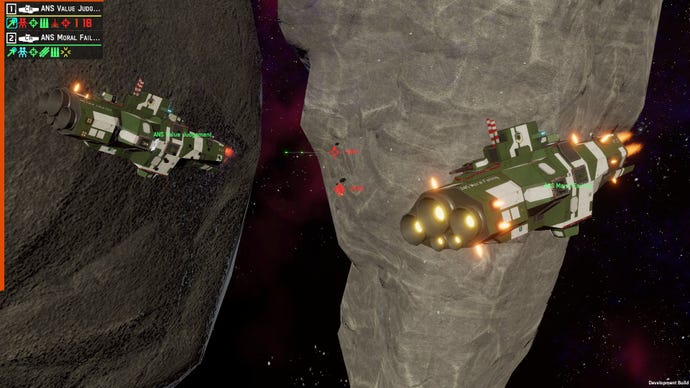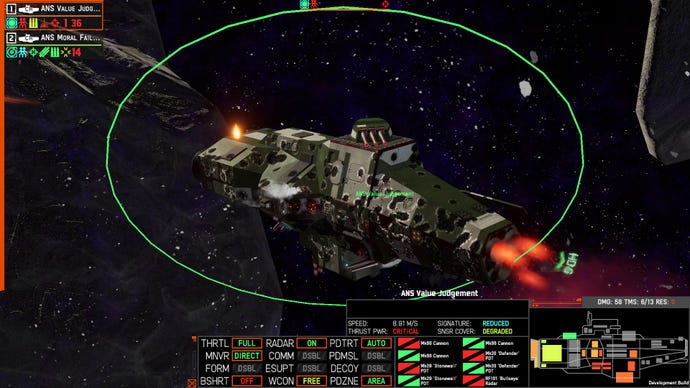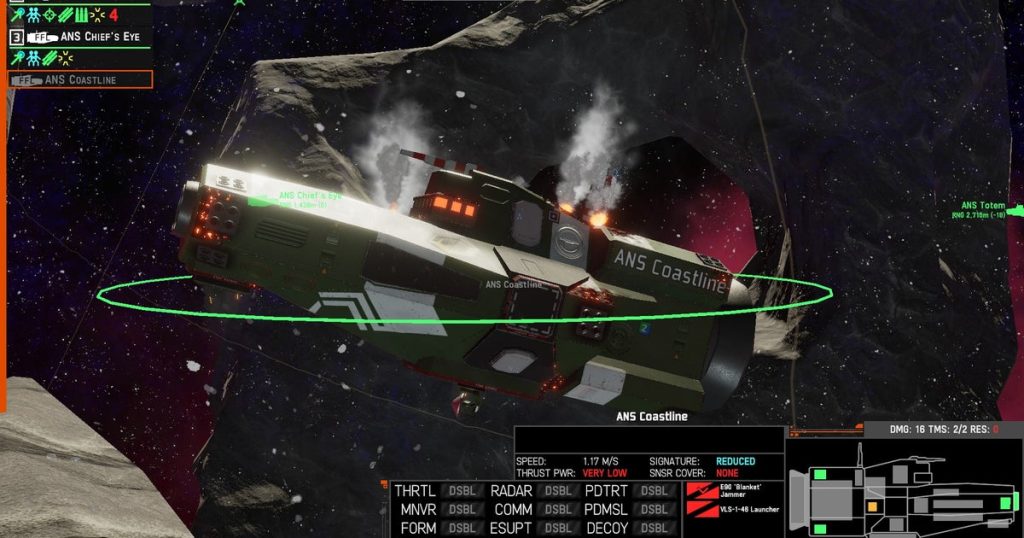Every “incoming missile” alert in Nebulous: Fleet Command spawns a host of questions, scattering through your brain pan like chaff. The most important of those questions is: “which missiles, exactly?” There are many species of self-propelled ordnance in this dangerously engrossing space sim from Eriadanus Industries – you can design your very own in the fleet editor – and while all are bad news, some are far worse than others.
The least deadly varieties take their targeting information from the ship that fired them. In a straightforward engagement, you’ll be able to see the vessel in question, but craftier admirals might use one tougher frontline ship as a spotter, sharing lock-on data with another undetected vessel lurking in the radar shadow of an asteroid. If there are no ships visible at all, the missiles could be self-guided with their own radar equipment, and the knock-on question there is exactly how far away they’ve come from, and via what precise twists and turns.
NEBULOUS: Fleet Command – Modular Missiles Update Release Trailer
I haven’t managed this myself, but according to Fleet Command’s dense tutorial missions, you can plot paths for certain kinds of missile, waypointing them around the map to catch the enemy flagship from behind, then letting the homing mechanisms take over (which assumes the enemy flagship is where you think it is). Given that such missiles share sensor data with the rest of your fleet that fired them, they can also be used for reconnaissance, though you certainly shouldn’t treat them like disposable probes.
Both these varieties of rocket-powered nuisance can be dispersed or destroyed using launchable decoys, point-defence turrets and “cunning” evasive manoeuvres – aka, slam that frigate around by 120 degrees and set to “flanking” speed, at the risk of burning out your engines. Changing direction is very effective given reasonable timing. Many missiles, you see, have their targetting data loaded into them the second before they fire, so if you alter course immediately after they fire, you can throw off the incoming salvo.
But every so often, you read the horrible word “hybrids”. These are the velociraptors of the missile menagerie, equipped with a second-stage “sprint” feature that makes rudimentary evasion and point defence all but useless. The game’s kindly tutorial lady describes avoiding a hybrid as like avoiding a telegraph pole that is corkscrewing towards your face at a kilometre a second. Which I think is underselling it, because telegraph poles do not have massive bombs attached to them, and they aren’t capable of tracking your movements across several million cubic kilometres of vacuum.

There are two things that can stop a hybrid. Firstly, laser turrets. And secondly, another missile, providing it’s launched well before the hybrid’s sprinting phase. Offensive missile vs defensive missile exchanges are among the many quiet beauties of a simulator that can seem desperately fiddly and obscure – nebulous, one might say – with an acronym-sodden HUD’s worth of menus within menus. Glittering red darts surge out of the black and are joyfully met by a coruscating green swarm of smaller interceptors, bursting into puffs of foil. It’s lovely to witness. But then a few of the red darts make it through, and now you’ve got no thrusters or radar coverage down one whole side of your cruiser.
I’m picking apart all these details in hindsight, flashback by flashback. During the handful of Nebulous: Fleet Command battles I’ve played, I’ve been swamped in white noise, paralysed by the spectacle of icons converging on my battered and protesting fleet. Fleet Command can feel absolutely overwhelming. The early access build gives you little in the way of an on-ramp beyond the tutorial – no story mode, at the time of writing, just a selection of deathmatch variants and objective modes to play against the AI or, shudder, the game’s small community of inevitably over-practised players. But if you’re any kind of naval tactics nerd, Fleet Command is fascinating to think about.
Let’s talk about direct fire engagements – a complicated dance of hulls that is at once agonisingly slow and incredibly fast. Slow, because the game’s ships are ponderous – having locked onto an enemy, it may take them moments to get close enough that every shot has positive odds of connecting. And fast, because there are a frightful number of micro-managerial decisions to make while these juggernauts are approaching each other.
For one thing, there’s the question of spreading out your damage. Every ship in Fleet Command is a 3D arrangement of components and armour-plating. When you come under fire, the components on that side get hit first. Thus, if you charge directly at something that’s shooting armour-piercing shells at you, your ship’s forward components will end up full of holes. This includes your bow thrusters, which will be a problem for you when you realise your fuel lines are on fire and struggle to reverse out of harm’s way.

So what you want to do instead is “angle-tank”. Fleet Command offers up a dizzying assortment of movement options, from plotting out patrols through having ships orbit a point in space to ordering your ship to travel in one direction indefinitely. When it comes to straight-up duels, you can give your ship a heading, which forces them to fly at a certain angle to the direction of movement. This will likely make inefficient use of their thrusters, but it will also hopefully mean that incoming shells hit your armour at an angle, deflecting a bit of damage.
Still, the components on that side will still take a beating. So you’ll probably want to keep rolling and angling your frontline ships as they advance on the other fleet, to layer out the punishment. Doing this will also reduce the chances that your repair teams – represented as tiny hammer icons, roving each vessel’s schematic – aren’t killed when patching up systems under fire. But don’t roll around willy-nilly, because there are certain parts of your ship that shouldn’t take damage in any circumstances. The comms systems that allow ships to receive orders, for instance, or the power reactor. If it takes too much heat it might overload, which is not a great outcome for either the spacecraft in question or any vessels nearby.
Phew. Phew! It’s a lot, isn’t it? I haven’t even touched upon the basics of reconnaissance and electronic warfare – actively jamming enemy radar with cones of static, or minimising the odds of being scanned by spacing formations out and turning ships to present a smaller surface area for radar waves to bounce off. I haven’t mentioned crew morale, or how you can tweak certain systems on the go – having your missiles launch “cold” and ease around the launching ship with thrusters before engaging their main engine, for example, to ensure an unobstructed line of flight.

At times Nebulous: Fleet Command feels like a vicious trap for Homeworld players desperate to play something, anything in the same vein. It certainly takes inspiration from the grand old dame of 3D real-time space strategy – the same boxy, diecast ship aesthetics, and a familiar bass drop when you switch to the holographic planner view. But then you try to play it like Homeworld, and realise you can’t just drag-select fleets and right-click them at the enemy – this is a Serious Simulation, in which your prowess as an admiral can be deduced near-exactly from the distribution of shell craters on each hull.
Again, it can be absolutely overwhelming. But it’s never brutally so. Look at the delicacy and obvious delight with which all these moving parts have been put together. Marvel at the symphony of each ship in motion – the way its course and orientation correspond to the flickering of thrusters across its length, as though the hulk were skimming through the void on feathers. If Eridanus Industries can find a way to convey the intricacies of Fleet Command more gradually, perhaps expanding the current narrated tutorial into a full single player campaign, this could be a space navy simulator for the ages.



